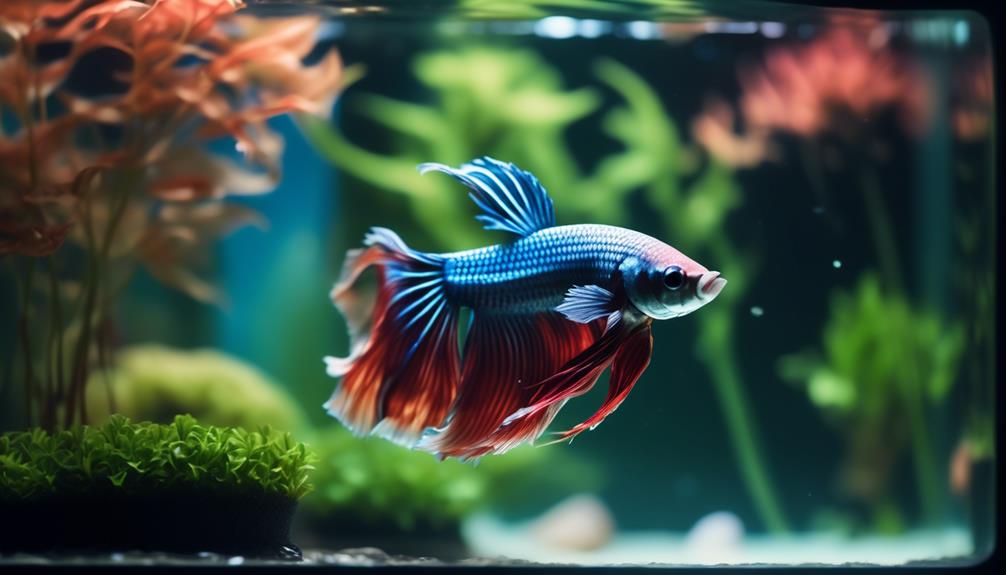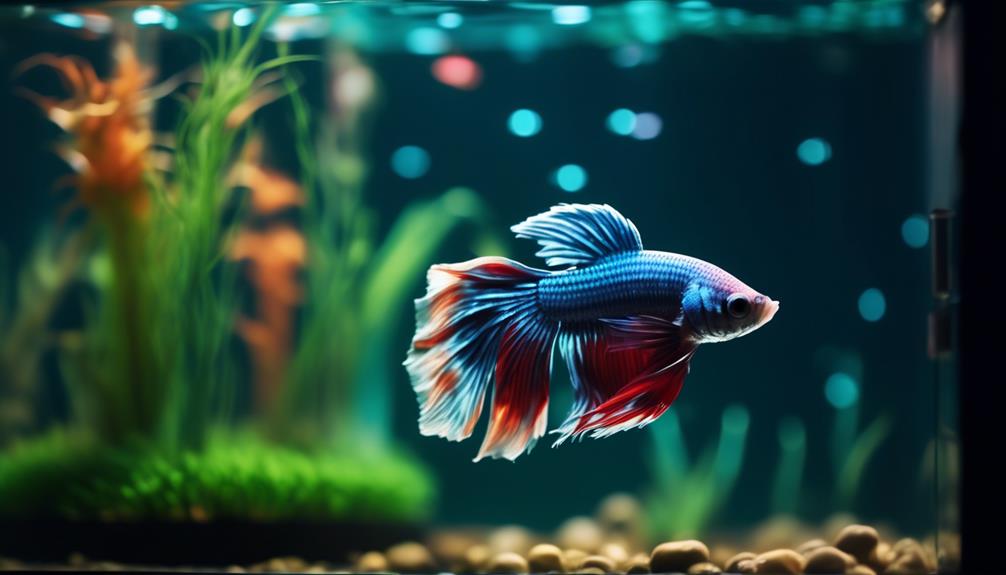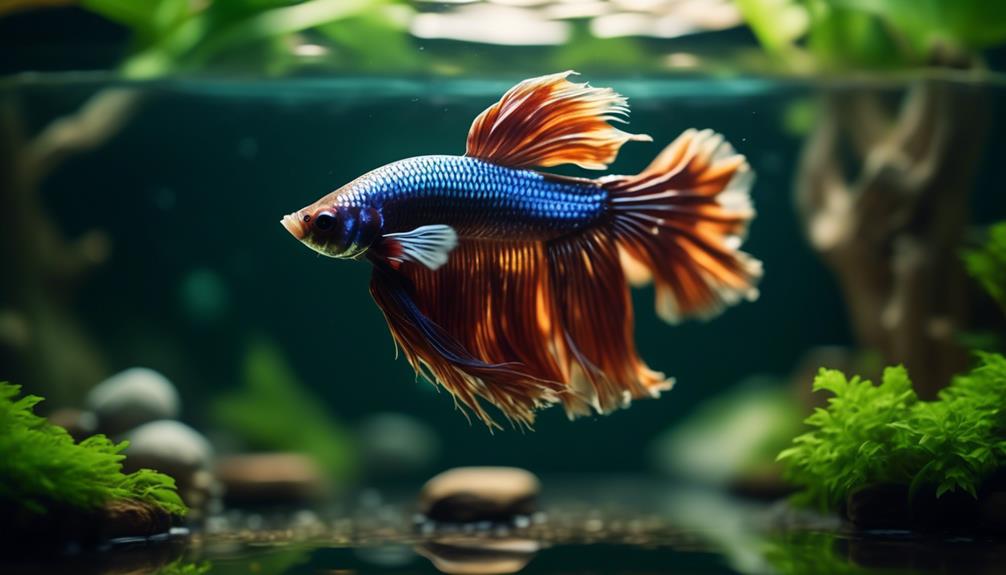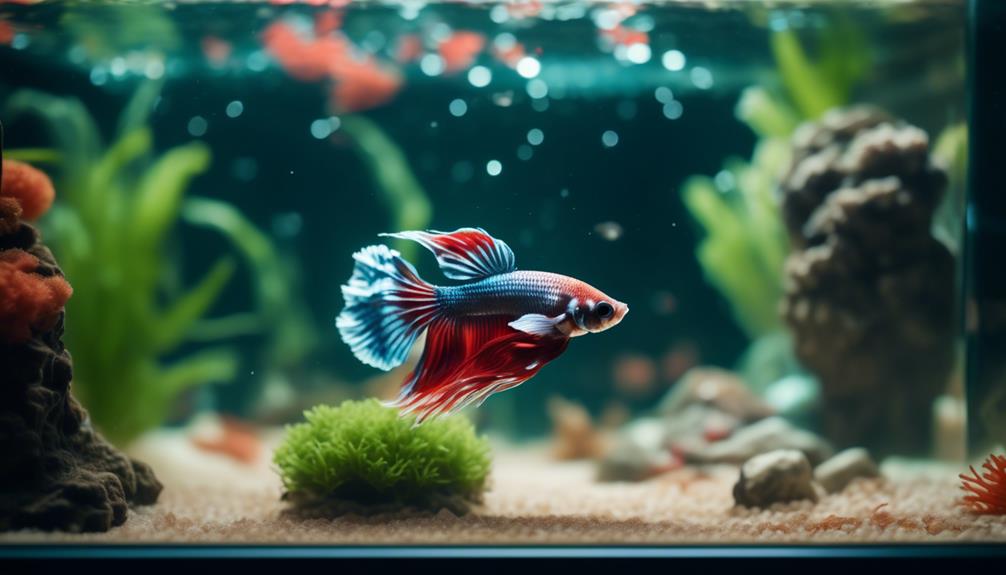Betta fish need the right pH level to be happy and thriving. But it’s not easy to maintain such a level. I know because I’ve tried and seen what happens when it’s wrong.
To help your Bettas, I have some tips that can help.
Mike’s Thoughts

Regular testing and careful adjustments are necessary to prevent potential harm to the Betta.
Effective and simple methods ensure the water’s pH remains within the safe range, providing a comfortable environment for the fish.
For those interested in learning more about the importance of pH levels for Betta fish and how to maintain them, I’ve included additional information below.
Feel free to read on and if you have any questions or want to discuss further, leave a comment below or you can reach me on Facebook.
Understanding Betta Fish pH Needs
Why is pH so crucial for the health of your Betta fish? Well, if the pH isn’t right, my Betta could get stressed, sick, or worse.
Betta fish thrive best when the water’s pH is stable, ideally between 6.8 and 7.5.
It’s not just about hitting a perfect number, though – it’s more about keeping things consistent.
I make sure to check the pH regularly. I use test strips, liquid tests, or even digital tests to keep an eye on it.
When the pH needs adjusting, I go slow.
If I need to lower the pH, I might add some driftwood or use products designed for that purpose.
But I’m always careful – changing things too fast can shock my Betta.
Sometimes, the pH might need a little boost. I can do this by increasing aeration or doing water changes.
Some folks even add a bit of baking soda or crushed coral. Again, the key is to make these changes little by little.
Understanding the ideal pH level for Betta and the safe pH range is a big deal. It’s not just about numbers; it’s about my Betta’s well-being.
The Science of Water pH

Diving into the science of water pH, it’s essential to know that this measure reflects how acidic or alkaline the water in your Betta’s tank is.
The pH scale goes from 0 to 14, with 7 being neutral.
Betta fish thrive when the water pH is just right, not too low, not too high.
Here’s a quick look at what different pH levels mean for your Betta:
| pH Level | Meaning |
|---|---|
| Below 6.8 | Too acidic for Betta fish |
| 6.8 to 7.5 | Ideal range for Betta fish |
| Above 7.5 | Too alkaline for Betta fish |
| Exactly 7.0 | Neutral, but stability is more important |
I’ve learned that keeping the pH levels stable is vital. Betta fish can get stressed or sick if the pH swings too much. So, I make sure to test the water regularly.
If I need to adjust the pH, I do it slowly. Adding driftwood can bring the pH down, while aeration can push it up. But I always take my time, because Betta fish don’t like sudden changes.
Maintaining the right water pH is key for my Betta’s health. It’s not about hitting a perfect number but about keeping the water conditions consistent within the range they like.
Testing Your Aquarium’s pH

I’ve learned that keeping an eye on my betta’s water pH is key to their health, so I test it regularly.
If the test shows the pH is off, I know it’s time to adjust the water carefully.
I’ll discuss how to choose the right test, understand the results, and safely change the aquarium’s pH.
Choosing a pH Test
When selecting a pH test for your aquarium, it’s important to understand the different types available, including paper test strips, liquid tests, and digital tests, each with its own pros and cons.
Here’s what I consider when I test the water:
1. Paper Test Strips: They’re quick and easy to use, but not always the most accurate.
No products found.
2. Liquid Tests: These take a bit more effort but tend to provide more precise results.
No products found.
3. Digital Tests: They offer the highest accuracy but can be costlier.
No products found.
I’m careful with pH adjusting; it’s a delicate process. I always aim for gradual changes to avoid shocking my betta.
Regularly checking and tweaking the pH ensures a stable home for my little buddy. I keep records to spot any trends or sudden shifts.
Interpreting Test Results
After determining which pH test works best for my aquarium, it’s time to understand what the results mean for my betta’s health.
If I find the pH is outside the ideal range of 6.8 to 7.5, it’s crucial to make necessary adjustments.
When the pH is too low, I can gradually raise it by adding a bit of baking soda or using aeration. Conversely, if it’s too high, I can add driftwood or peat moss to naturally lower it.
I always aim for stability to avoid stressing my betta. Sudden swings in pH can be harmful. That’s why I monitor regularly and act slowly when making changes.
Keeping detailed records helps me spot trends and adjust my approach as needed to maintain a healthy environment for my betta.
Lowering pH

Step 1: I’ll start by introducing driftwood or peat moss into the filter, as it’s a safe way to gradually lower the pH in my Betta fish tank.
Peat moss releases tannins slowly, which naturally brings down the pH without shocking my fish. This method isn’t just effective; it’s also gentle on the ecosystem I’ve worked hard to establish.
Step 2: If I need to adjust the pH further, I’ll consider adding almond leaves to the water.
These leaves are great for Betta fish because they mimic their natural habitat. The tannins from the almond leaves work like peat moss, lowering the pH slowly and safely.
I’m careful not to rush the process. I know that a stable environment is crucial for the health of my Betta.
So, I’ll monitor the pH levels closely, making sure they decrease steadily. I aim for a slightly acidic pH, around 6.8 to 7.5, which is ideal for my Betta’s well-being.
Step 3: I avoid using chemical pH adjusters unless absolutely necessary.
If I do use them, I’ll add them cautiously and in small amounts. My goal is always to keep my Betta happy and stress-free, and a big part of that’s ensuring their water is just right.
Raising pH

While I carefully lower the pH for my Betta, there are times when I might need to raise it to keep the water conditions optimal.
Balancing the pH is a critical part of fish care, and raising it can be just as important as lowering it. Here’s how I tackle the task:
- Baking Soda: I’ve found that adding a bit of baking soda to the aquarium water can effectively change the pH. It’s a gentle method, but I make sure to add it slowly and measure the pH as I go to avoid sudden changes that could stress my Betta.
- Crushed Coral: Another way I increase the pH is by using crushed coral as a substrate or placing it in the filter. Crushed coral slowly releases minerals into the water, which can raise the pH naturally over time.
- Aerate More: I step up the aeration in the tank. More aeration means less carbon dioxide in the water, which can help to naturally raise the pH. I make sure the air pump is running efficiently, and sometimes I add an additional air stone to ensure there’s plenty of oxygenation happening.
- Changing water more regularly.
What Causes High or Low pH In Aquariums?
High pH values
1. Overactive biological processes: Excessive biological activity in the aquarium, such as overfeeding, overstocking, or inadequate filtration, can lead to high pH levels due to the release of excess waste and organic material.
2. Using alkaline substrates or decorations: Certain substrates, rocks, or decorations in the aquarium can raise the pH levels, especially if they contain calcium carbonate or other alkaline materials.
3. Carbonate hardness (KH) levels: High levels of carbonate hardness in the water can contribute to a more stable and higher pH. This is because carbonate hardness acts as a buffer against pH changes.
4. Tap water parameters: If the tap water used for aquarium maintenance has naturally high pH levels, it can directly impact the aquarium water’s pH when added during water changes.
5. Substrate: The substrate you are using.
Low pH values
1. Carbon Dioxide (CO2) buildup: Decaying organic matter, overstocking, and inadequate aeration can lead to high levels of CO2 in the water, causing a drop in pH.
2. Lack of buffering capacity: The water may not have sufficient carbonate hardness (KH) or other buffering agents to maintain a stable pH.
3. Acidic substrate or decorations: Certain substrates and decorations, such as driftwood or peat, can release tannins and organic acids, lowering the pH of the water.
4. Nitrification process: The biological breakdown of organic waste and ammonia by beneficial bacteria can release acids, leading to a decrease in pH.
5. Poor water quality: Accumulation of organic waste, uneaten food, and decaying plants can contribute to acidic conditions in the aquarium.
Importance of Stable pH Levels
I’ve noticed that keeping the pH stable in my betta’s tank is key to their health. When the pH swings too much, my fish seems stressed, and I worry it could get sick or worse.
It’s clear that a steady pH range helps bettas act normal and stay happy.
pH Impact on Health
Although Betta fish can adapt to a range of pH levels, maintaining stable pH between 6.8 and 7.5 is crucial for their health. A safe range for the pH level for Betta is important because:
- Stress Reduction: Keeping the pH within this range helps prevent stress, which can weaken their immune system.
- Disease Prevention: A stable pH level reduces the risk of illness. Betta fish are less likely to get sick in a consistent environment.
- Longevity: By avoiding sudden pH changes, I’m supporting their overall well-being and potentially extending their lifespan.
I regularly test the water to ensure the pH stays on target. It’s not just about hitting the right number; it’s about keeping it stable for my Betta’s health.
Stress Reduction Through Stability
Having established the optimal pH range for my Betta fish, it’s crucial to focus on why keeping this level stable is key to reducing their stress. Stable water parameters prevent sudden changes that can upset my Betta.
When pH levels swing, it’s tough on their bodies and can make them sick. I regularly check the pH to ensure it stays between 6.8 and 7.5. This stability means a happier, healthier fish.
Making changes to the water should be slow and careful. Quick shifts are a no-no; they can shock my Betta. I’m all about giving my fish a steady environment.
It’s simple: steady pH equals less stress. And less stress means a thriving Betta. That’s why I’m committed to maintaining the stability of my Betta’s water.
Betta Behavioral Indicators
Observing my Betta’s behavior closely, I can tell that stable pH levels play a pivotal role in their health and mood. When the pH swings too much, I’ve noticed my little buddy shows signs of stress. To keep things ideal, I’ve learned to watch for these behavioral indicators:
- Activity Level: A happy Betta is active and curious. If they’re lethargic or hiding more than usual, it might be a pH issue.
- Eating Habits: Bettas with a good appetite are generally healthy. A sudden lack of interest in food could signal a problem with the water’s pH.
- Appearance: Clamped fins or faded colors often mean stress, possibly from pH levels that aren’t ideal.
Keeping the pH stable means my Betta stays vibrant and energetic!
Impact of Incorrect pH Values

Maintaining the correct pH level is vital for a betta fish’s health, as incorrect values can lead to stress and disease. The ideal pH level for betta fish keeps them happy and healthy.
When the pH isn’t right, they suffer. It’s like if you tried to breathe bad air – you’d get sick, and so do they.
If the pH swings too much or changes quickly, it can really mess with a betta’s body. They can get weak and fall ill because their immune systems can’t cope with the stress.
Stability is key; without it, they can’t act normal or stay well. It’s like living in a house that’s always shaking – you’d never feel safe or settled.
I’ve seen what happens when the pH jumps or drops suddenly. The betta gets hit by osmotic shock. It’s a tough battle for them, and some can’t make it through.
That’s why I keep a close eye on the water, making sure it stays at the ideal level.
In short, the impact of incorrect pH values is no small thing. It can mean life or death for a betta fish.
So, I don’t take chances. I monitor and adjust, keeping their world as perfect as I can.
Maintaining pH in Betta Tanks

To ensure a betta’s health, it’s crucial to regularly check and adjust the pH level in their tank. Bettas need stable water conditions to thrive, and that includes maintaining the pH between 6.8 and 7.5.
Here’s how I keep the pH in my betta tank just right:
- Regular Testing: I test the water weekly with a reliable pH test kit. This keeps me informed of any changes so I can act quickly to correct them.
- Gradual Adjustments: If I need to adjust the pH, I do it slowly. For lowering pH, I might add driftwood, and for raising it, I might use a bit of baking soda. It’s vital not to shock my little buddy with sudden changes.
- Consistent Water Changes: I perform regular water changes, usually about 20-25% of the tank water each week. This helps maintain good water quality and keeps the pH level stable.
Tips for Regular pH Management

I often use paper test strips for quick pH checks to keep my betta’s water within the safe range.
It’s simple: dip the strip in the water, and it tells me if I need to adjust anything. To make the water just right, I go slow. I’ve learned that my betta can handle a bit of up and down in pH, as long as it’s between 6.8 to 7.5.
They don’t like big, sudden changes though, so I’m always careful.
If I need to tweak the pH, I don’t rush it. I might put a piece of driftwood in the tank, which can lower the pH naturally over time. It’s better than using chemicals that could shock my little buddy.
When I do water changes, I check the tap water too. It can be different from what’s in the tank, so I match them up as best I can before pouring it in.
I keep in mind if there are other fish with my betta, making sure they all like the same kind of water.
It’s a balancing act, but keeping my eye on the pH helps my betta stay happy and healthy.
Frequently Asked Questions
How Do I Fix the pH Level in My Betta Fish Tank?
To fix my tank’s pH, I’d use acidic additives for alkalinity reduction if it’s too high, or I’d add baking soda to raise it. I’d make changes slowly to avoid shocking my betta.
Is 8.2 pH Too High for Betta?
Yes, 8.2 pH is too high for me. I prefer more acidic water. I’ll test the pH and adjust it, keeping my betta’s health in mind. Stability is key, so I’ll aim for gradual changes.
Will Betta Water Conditioner Lower pH?
I’ve found that betta water conditioner might stabilize pH but doesn’t directly lower it. For water hardness issues, I’d choose a conditioner type that’s designed for adjusting pH levels.
What Causes High pH in Betta Tank?
I’ve noticed high pH in my tank because of certain materials and overfeeding issues. Rocks and shells can release minerals, and leftover food increases waste, both contributing to the problem.
Can pH levels change during the day?
It’s totally normal. The plants and fish in the tank can cause the pH to go up and down.